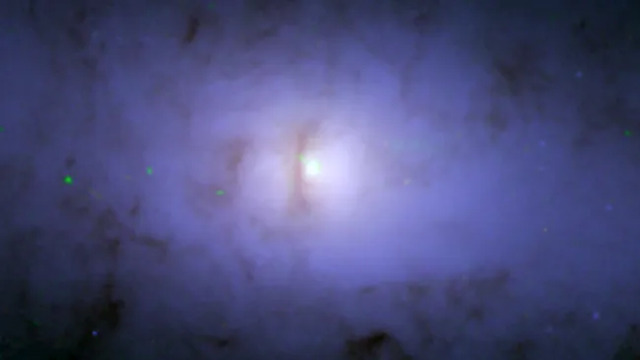
A recent image captured by the Hubble Space Telescope shows the core of galaxy NGC 5084. In the image, a dark vertical line near the center reveals a dusty disk surrounding the core. This disk, along with the way it aligns, suggests the presence of a supermassive black hole. Both the disk and the black hole appear to be tilted, positioned at an angle to the galaxy's horizontal orientation. NASA
In an unexpected discovery, scientists have uncovered a strange black hole tilted onto its side in a distant galaxy, offering a glimpse into an eventful and violent history. This surprising find was made possible by a collaboration between NASA’s Hubble Space Telescope and the Chandra X-ray telescope, which together revealed a bizarre galactic structure. The black hole is located in the galaxy NGC 5084, which lies about 80 million light-years away in the Virgo constellation.
The unusual black hole was tipped off to researchers through an unusual galactic formation—a pair of X-shaped plumes of plasma. One of these plumes stretches above and below the galaxy's plane, while the other cuts across the galaxy, creating an X-shape never before seen by astronomers. This rare structure immediately grabbed the attention of the research team, who suspected that a major event in the galaxy's past had knocked the black hole into its tilted position.
Pamela Marcum, an astrophysicist at Ames Research Center, emphasized the significance of the discovery, stating, "Detecting two pairs of X-ray plumes in one galaxy is exceptional. The combination of their unusual, cross-shaped structure and the 'tipped-over,' dusty disk gives us unique insights into this galaxy's history."
The team began investigating the black hole's odd orientation, which was initially revealed by Chandra's X-ray data. Researchers used a new image analysis technique, "Selective Amplification of Ultra Noisy Astronomical Signal" (SAUNAS), to highlight low-brightness X-ray emissions. This technique helped them spot the peculiar X-shaped plasma plumes. Normally, X-ray emissions from galaxies are spread out evenly, forming a spherical pattern. However, the concentrated shape of these X-rays suggested that something dramatic had occurred in the galaxy’s past.
Excited by the anomaly, the scientists combed through decades of archival data and conducted new observations with advanced telescopes. Using the Hubble Space Telescope and the Atacama Large Millimeter/submillimeter Array (ALMA) in Chile, they found a dusty ring surrounding the black hole, confirming that it was indeed tilted at a 90-degree angle to the galaxy's plane.
“It was like seeing a crime scene with multiple types of light,” explained Alejandro Serrano Borlaff, the team leader at Ames Research Center. “Putting all the pictures together revealed that NGC 5084 has changed a lot in its recent past."
The team suspects that a collision with another galaxy could be responsible for this unusual orientation of the black hole. This violent cosmic interaction may have generated a “chimney” of plasma, which erupted from the galaxy’s plane and gave rise to the X-shaped plumes. Though more studies are needed to confirm this theory, the discovery highlights the power of using archival data and advanced processing techniques to reveal new cosmic mysteries.
In the ongoing investigation, researchers are continuing to study NGC 5084 to better understand the event that may have tilted the black hole. This discovery not only sheds light on a previously unknown aspect of galactic dynamics but also illustrates how innovative techniques can unlock hidden secrets of the universe.















